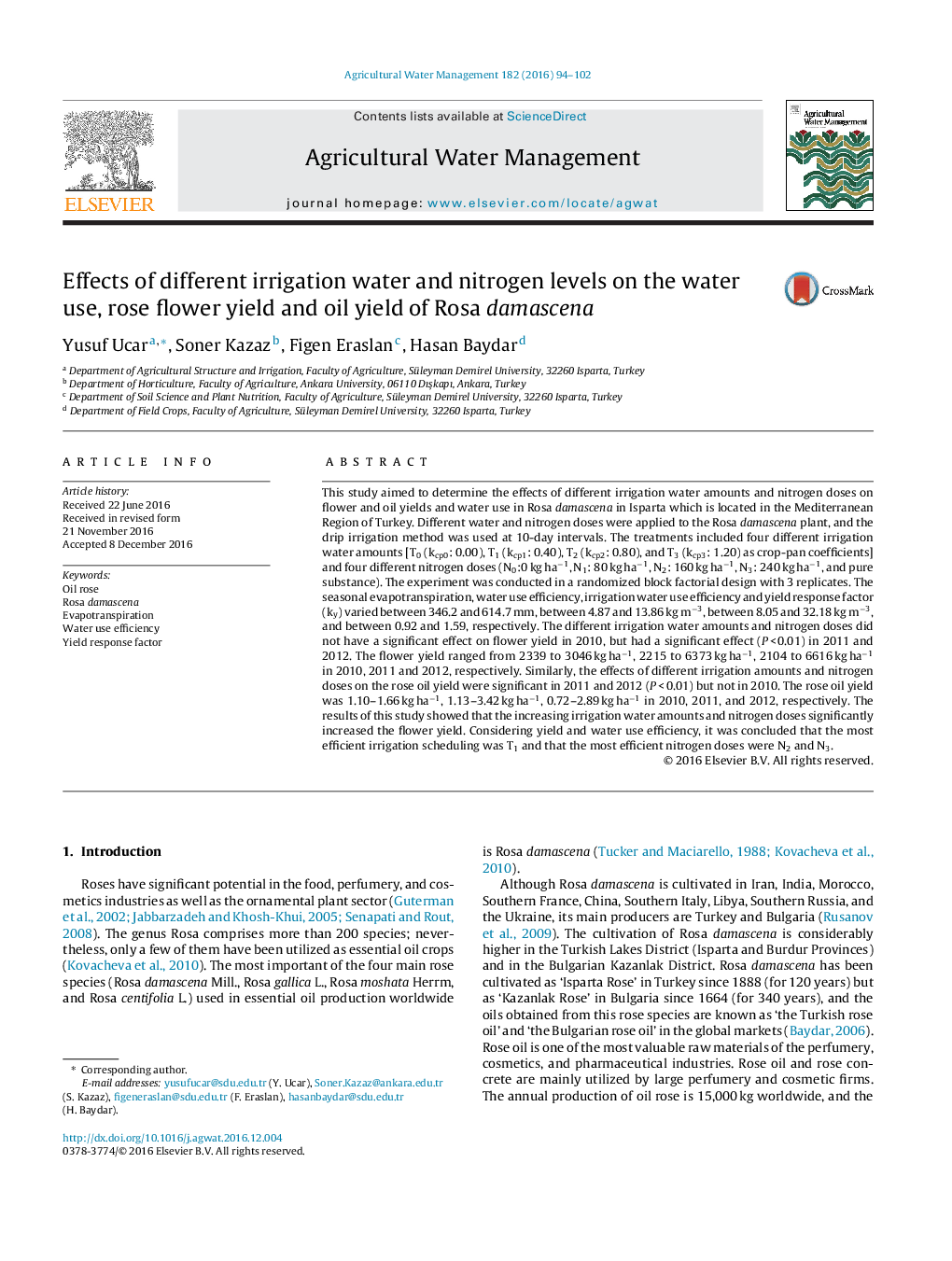| کد مقاله | کد نشریه | سال انتشار | مقاله انگلیسی | نسخه تمام متن |
|---|---|---|---|---|
| 5758556 | 1622898 | 2017 | 9 صفحه PDF | دانلود رایگان |
عنوان انگلیسی مقاله ISI
Effects of different irrigation water and nitrogen levels on the water use, rose flower yield and oil yield of Rosa damascena
ترجمه فارسی عنوان
اثر سطوح مختلف آبیاری و نیتروژن بر مصرف آب، عملکرد گل رز و عملکرد روغن رزا دماسکن
دانلود مقاله + سفارش ترجمه
دانلود مقاله ISI انگلیسی
رایگان برای ایرانیان
کلمات کلیدی
نفت افزایش یافت، رزا داسکنا، تبخیر تعرق، بهره وری استفاده از آب، فاکتور پاسخ عملکرد
موضوعات مرتبط
علوم زیستی و بیوفناوری
علوم کشاورزی و بیولوژیک
علوم زراعت و اصلاح نباتات
چکیده انگلیسی
This study aimed to determine the effects of different irrigation water amounts and nitrogen doses on flower and oil yields and water use in Rosa damascena in Isparta which is located in the Mediterranean Region of Turkey. Different water and nitrogen doses were applied to the Rosa damascena plant, and the drip irrigation method was used at 10-day intervals. The treatments included four different irrigation water amounts [T0 (kcp0: 0.00), T1 (kcp1: 0.40), T2 (kcp2: 0.80), and T3 (kcp3: 1.20) as crop-pan coefficients] and four different nitrogen doses (N0:0 kg haâ1, N1: 80 kg haâ1, N2: 160 kg haâ1, N3: 240 kg haâ1, and pure substance). The experiment was conducted in a randomized block factorial design with 3 replicates. The seasonal evapotranspiration, water use efficiency, irrigation water use efficiency and yield response factor (ky) varied between 346.2 and 614.7 mm, between 4.87 and 13.86 kg mâ3, between 8.05 and 32.18 kg mâ3, and between 0.92 and 1.59, respectively. The different irrigation water amounts and nitrogen doses did not have a significant effect on flower yield in 2010, but had a significant effect (P < 0.01) in 2011 and 2012. The flower yield ranged from 2339 to 3046 kg haâ1, 2215 to 6373 kg haâ1, 2104 to 6616 kg haâ1 in 2010, 2011 and 2012, respectively. Similarly, the effects of different irrigation amounts and nitrogen doses on the rose oil yield were significant in 2011 and 2012 (P < 0.01) but not in 2010. The rose oil yield was 1.10-1.66 kg haâ1, 1.13-3.42 kg haâ1, 0.72-2.89 kg haâ1 in 2010, 2011, and 2012, respectively. The results of this study showed that the increasing irrigation water amounts and nitrogen doses significantly increased the flower yield. Considering yield and water use efficiency, it was concluded that the most efficient irrigation scheduling was T1 and that the most efficient nitrogen doses were N2 and N3.
ناشر
Database: Elsevier - ScienceDirect (ساینس دایرکت)
Journal: Agricultural Water Management - Volume 182, 1 March 2017, Pages 94-102
Journal: Agricultural Water Management - Volume 182, 1 March 2017, Pages 94-102
نویسندگان
Yusuf Ucar, Soner Kazaz, Figen Eraslan, Hasan Baydar,
